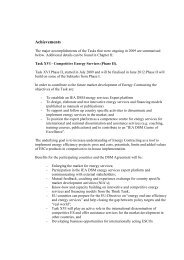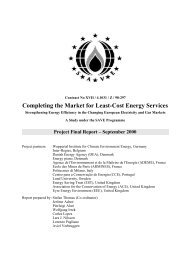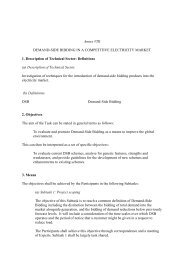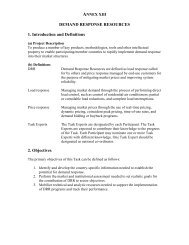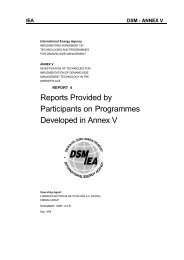Summary and conclusions - IEA Demand Side Management ...
Summary and conclusions - IEA Demand Side Management ...
Summary and conclusions - IEA Demand Side Management ...
Create successful ePaper yourself
Turn your PDF publications into a flip-book with our unique Google optimized e-Paper software.
4 Subtask 5: Assessment of technologies <strong>and</strong> theirpenetration in participating countriesSubtask 5 deals with the emerging generation, end-use <strong>and</strong> ICT technologies at customer premises.Five separate technology reports were produced: Subtask 5, Report n:o 1. Full electric <strong>and</strong> plug-in hybrid electric vehicles from the powersystem perspective [1] Subtask 5, Report n:o 2. Micro-CHP technologies for distributed generation [4] Subtask 5, Report n:o 3. Heat pumps for cooling <strong>and</strong> heating [5] Subtask 5, Report n:o 4, Photovoltaic at customer premises [6] Subtask 5, Report n:o 5, Smart metering [7]These reports are shortly summarized in the following.4.1 Full electric <strong>and</strong> plug-in hybrid electric vehicles from the powersystem perspectiveThe report briefly reviews current electric vehicle technology, presents some future prospects, <strong>and</strong>presents some possible consequences to the power system, <strong>and</strong> ways in which the harmful effectscould be minimized. From the integration point of view the services offered by EV are interesting inthe longer run4.1.1 Services which can be offered by smart charging <strong>and</strong> V2GSmart charging <strong>and</strong> V2G can provide the same types of services to the power system as DR <strong>and</strong> DGin general. In the present situation an aggregator company is needed, which takes care ofcontracting <strong>and</strong> selling the power output provided by EV. The role of the aggregator is discussed inmore detail in Subtask 7 report.Charging (or discharging in case of V2G) reprofiling, which the DR provided by EV, can easily besold on the day-ahead <strong>and</strong> intra-day power markets. Naturally this requires that proper forecasts ofEV charging in normal situation (in absence of control signals) <strong>and</strong> forecasts of charging responsesto control signals are available <strong>and</strong> that control signals can be sent to EV chargers or HEMS reliably<strong>and</strong> quickly.Smart charging EV’s could not only charge (or discharge) according to the organized day-ahead <strong>and</strong>intra-day power markets, but also offer ancillary services to the TSO. Ancillary services are supportservices, whose purpose is not directly to provide power for consumer but to ensure the reliability<strong>and</strong> security of the grid. They include operating reserves, which maintain the frequency of the gridwithin acceptable margins, reactive power support <strong>and</strong> black start capability services.Balancing market is considered to lie in the grey area between electricity markets <strong>and</strong> ancillaryservices. EV with smart charging in principle can take part in balancing markets but the rules forparticipating vary from country to country.Reserves are used to correct small deviations in frequency that occur throughout time <strong>and</strong> toprovide backup power when large power plants or transmission lines unexpectedly trip off from thegrid. Reserves can be in some cases profitably provided by smart charging, depending on e.g. the6



